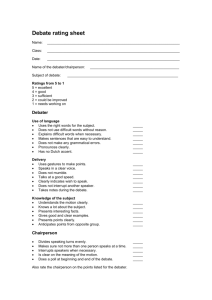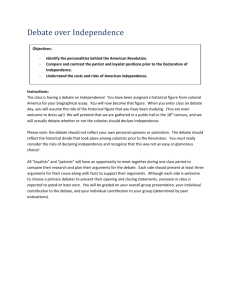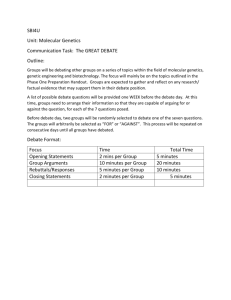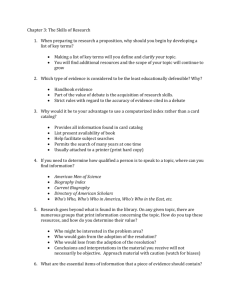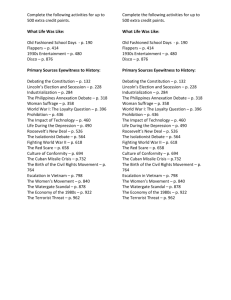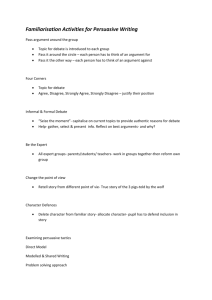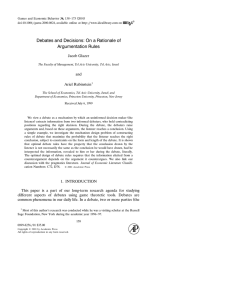BODY LANGUAGE IN DEBATING-2
advertisement
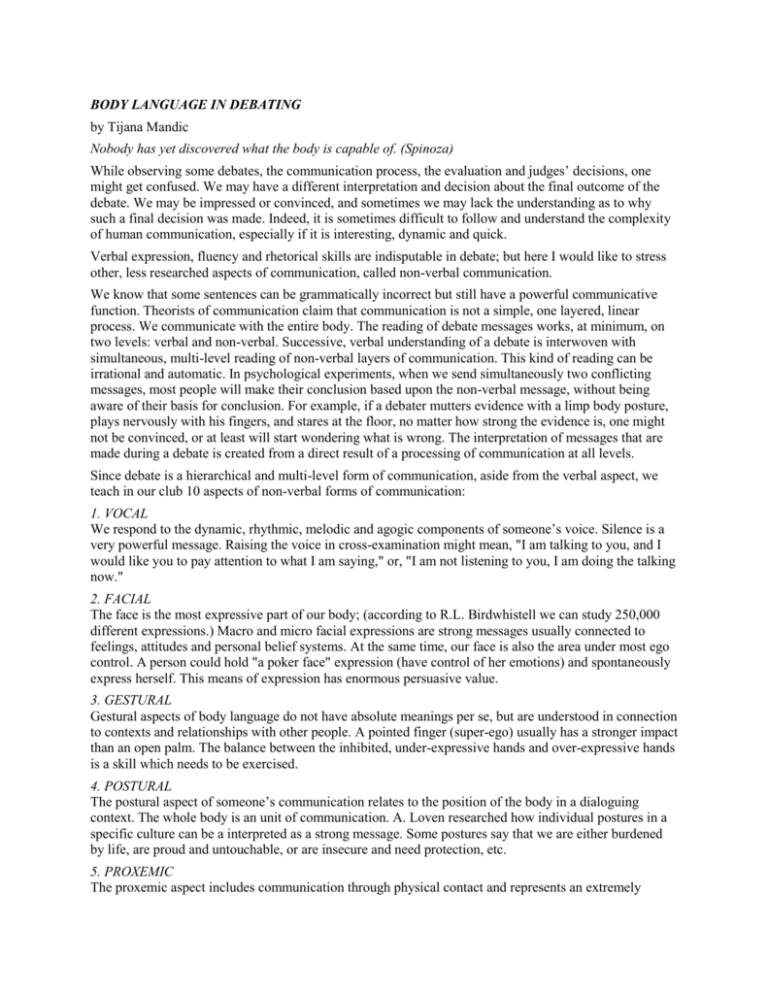
BODY LANGUAGE IN DEBATING by Tijana Mandic Nobody has yet discovered what the body is capable of. (Spinoza) While observing some debates, the communication process, the evaluation and judges’ decisions, one might get confused. We may have a different interpretation and decision about the final outcome of the debate. We may be impressed or convinced, and sometimes we may lack the understanding as to why such a final decision was made. Indeed, it is sometimes difficult to follow and understand the complexity of human communication, especially if it is interesting, dynamic and quick. Verbal expression, fluency and rhetorical skills are indisputable in debate; but here I would like to stress other, less researched aspects of communication, called non-verbal communication. We know that some sentences can be grammatically incorrect but still have a powerful communicative function. Theorists of communication claim that communication is not a simple, one layered, linear process. We communicate with the entire body. The reading of debate messages works, at minimum, on two levels: verbal and non-verbal. Successive, verbal understanding of a debate is interwoven with simultaneous, multi-level reading of non-verbal layers of communication. This kind of reading can be irrational and automatic. In psychological experiments, when we send simultaneously two conflicting messages, most people will make their conclusion based upon the non-verbal message, without being aware of their basis for conclusion. For example, if a debater mutters evidence with a limp body posture, plays nervously with his fingers, and stares at the floor, no matter how strong the evidence is, one might not be convinced, or at least will start wondering what is wrong. The interpretation of messages that are made during a debate is created from a direct result of a processing of communication at all levels. Since debate is a hierarchical and multi-level form of communication, aside from the verbal aspect, we teach in our club 10 aspects of non-verbal forms of communication: 1. VOCAL We respond to the dynamic, rhythmic, melodic and agogic components of someone’s voice. Silence is a very powerful message. Raising the voice in cross-examination might mean, "I am talking to you, and I would like you to pay attention to what I am saying," or, "I am not listening to you, I am doing the talking now." 2. FACIAL The face is the most expressive part of our body; (according to R.L. Birdwhistell we can study 250,000 different expressions.) Macro and micro facial expressions are strong messages usually connected to feelings, attitudes and personal belief systems. At the same time, our face is also the area under most ego control. A person could hold "a poker face" expression (have control of her emotions) and spontaneously express herself. This means of expression has enormous persuasive value. 3. GESTURAL Gestural aspects of body language do not have absolute meanings per se, but are understood in connection to contexts and relationships with other people. A pointed finger (super-ego) usually has a stronger impact than an open palm. The balance between the inhibited, under-expressive hands and over-expressive hands is a skill which needs to be exercised. 4. POSTURAL The postural aspect of someone’s communication relates to the position of the body in a dialoguing context. The whole body is an unit of communication. A. Loven researched how individual postures in a specific culture can be a interpreted as a strong message. Some postures say that we are either burdened by life, are proud and untouchable, or are insecure and need protection, etc. 5. PROXEMIC The proxemic aspect includes communication through physical contact and represents an extremely powerful human message. Is the debater touching himself, a member of his team or the opposite team; how is he doing it? It will be noticed at least subconsciously when, in the structure of his speech, he is doing such an action. Proxemic messages could be used, but with extreme caution, because they can be easily misinterpreted. 6. SPATIAL The spatial aspect represents an analysis of how the debater uses the stage or the space he is standing in or sitting on. Dominance, acceptance, extroversion, respect (for example, by not intruding on other people's territory) are only some of the information we get when observing someone's spatial behavior. 7. RHYTHM Rhythm in speaking and behaving is an organizing and integrating element of communication. It has several functions from the basic homeostatic to the aesthetic. The rhythm of breathing, eye movement, hands and legs, and the whole body gives meaning to someone’s expression. Carefully planned sudden changes in rhythm will increase attention and stress the importance of the speaker’s point. 8. MOVEMENT Movement is a macro statement in communication. Movement has to be discreet in debating, but it is nevertheless important. As the largest element in communication, it has integrative value and has to be congruent with the other aspects of communication. It can reveal basic motives, character traits and some practical intents of the person moving (Arheim R.) 9. CLOTHING AND BODY DECORATION These aspects are dependent on individual and collective ideals. A socially intelligent debater must be aware of the context and the message being sent by dressing style. Likewise, the debater is responsible for the shock created by an unusual or a rebellious style of dressing. 10. DRAWING Drawing is a natural but unusually rare form of communication in debate. Pictures, posters, graphs or other visual materials presented in a debate can make a strong impact; however, it is polyvalent, and therefore risky. Sensitivity, awareness, freedom and creativity in non-verbal expression can make enormous impact in debating. Becoming non-verbally fluent, centered, grounded and flexible, will not only develop selfesteem, fluency and flexibility but enable better communication skills in life. Integrating private and public personality (E. Goffman) is easier non-verbally. We strongly recommend exercises in NLP, TA, post Raichian, acting and creative movement workshops. Debate Newsletter Contents Table of Contents
